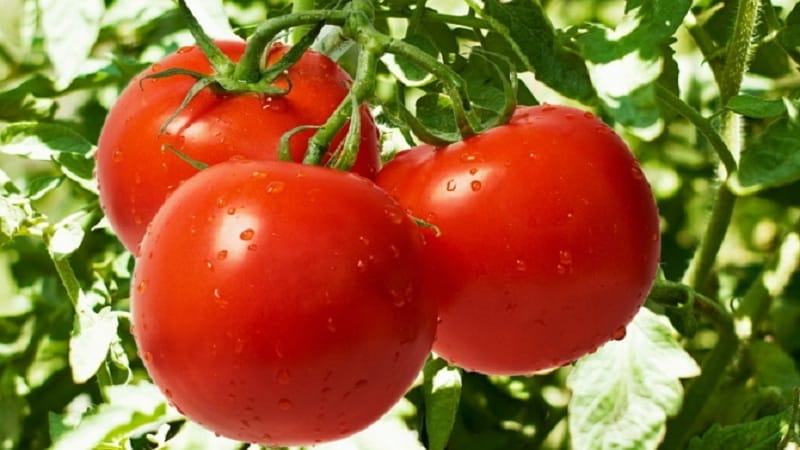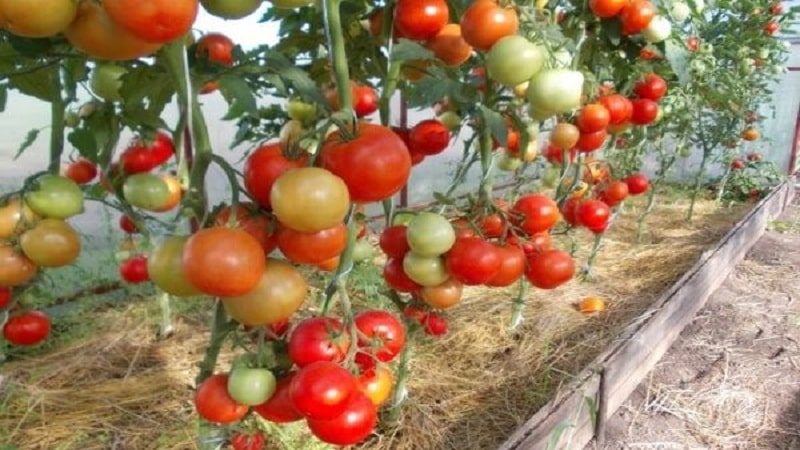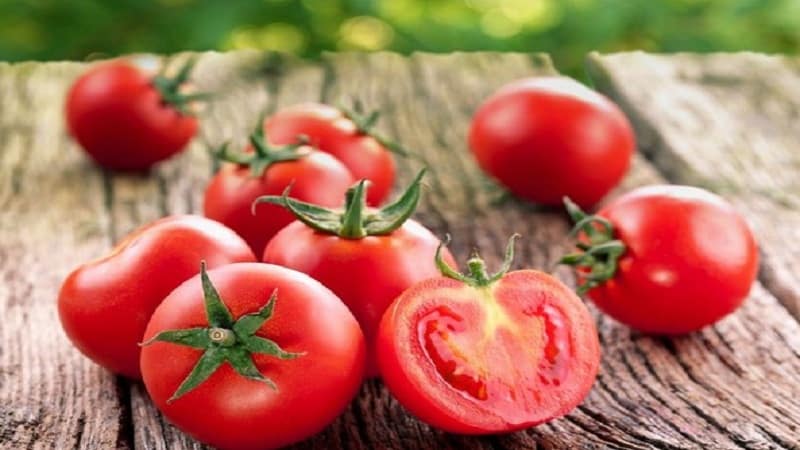A hybrid created by domestic breeders that produces an excellent harvest - the “Evpator” tomato.
A hybrid of Russian selection called Evpator is an ideal tomato for cultivation in regions with an unfavorable climate in closed ground. Suitable for summer-winter circulation. The fruits have a pleasant sweet and sour taste and a universal use in cooking.
In this article you will find a description of the variety, useful information about methods of growing in protected soil, the nuances of caring for the plant, and ways to combat diseases and insects.
Description of the hybrid
Tomato Evpator is a product of collaboration between breeders of the Research Institute for Breeding Vegetable Crops and Agrofirm Gavrish. The culture was included in the State Register of the Russian Federation in 2002.
Indeterminate The hybrid was created for cultivation throughout the country in an extended rotation. The bushes are medium-branched and require pinching and tying to stakes or trellises.
Tomatoes are grown in greenhouses because it is in such conditions that the plant reaches its full potential. In closed ground it is easier to create a favorable microclimate.
Bushes are able to form ovaries in large quantities at low air temperatures. The first inflorescence appears above the ninth leaf, subsequent ones - every 3 leaves. Each of them bears from 6 to 8 fruits.
In the photo - tomato Evpator f1.

Distinctive features
The table shows the characteristics of the hybrid.
| Indicators | Characteristic |
| Weight | 110-130 g |
| Form | Flat-round |
| Coloring | Red |
| Leaves | Medium size, dark green |
| Inflorescence | Compact, simple |
| Number of slots | 4 or more |
| Pulp | Juicy, meaty |
| Taste | Excellent, sweet and sour |
| Skin | Dense but not hard |
| Purpose | Universal |
| Bush height | 2-2.5 m |
| Ripening period | 107-110 days after germination |
| Productivity | 38-40 kg/m² |
| Sustainability | Tobacco mosaic virus, fusarium, cladosporiosis, root-knot nematode, fruit cracking |
| Transportability | High |
How to grow seedlings
Work on growing Evpator tomato seedlings begins in the second ten days of March. It includes soil preparation, sowing seeds, picking and caring for seedlings.
Preparing the soil and sowing seeds
Loose and nutritious soil is suitable for growing seedlings. The easiest way is to take a ready-made substrate, enriched with nutritional components, from a gardening store and calcine it in the oven at a temperature of 110 °C.
A more labor-intensive, but reliable option is to prepare the soil mixture yourself. To do this you will need turf, river sand and humus in a ratio of 1:1:1. The soil is also disinfected in the oven or treated with a strong solution of potassium permanganate.
Containers for seedlings are filled with moist soil and the grains are placed in 2 cm recesses, with an interval of 2-3 cm. Sprinkle the top with a 1 cm layer of soil, cover the containers with film and take them to a warm place. The air temperature for rapid germination is not lower than 25 °C.
Care
As soon as the sprouts hatch, the film is removed, and the boxes with seedlings are placed on the windowsill on the south side. Young seedlings need sufficient sunlight. The duration of daylight should be at least 16 hours. Phytolamps are used as an additional light source.
At the stage of 2-3 leaves, seedlings are planted in peat or plastic pots.
Caring for seedlings includes moderate watering 2-3 times every 10 days and a one-time fertilizing with ready-made mineral compounds: “Agricola”, “Universal”, “Effecton”.
Reference. 2 weeks before transferring to the ground, the seedlings are taken out into fresh air every day for hardening - for 30-60 minutes.
How to grow tomatoes
Hybrid Evpator is grown using standard technology in closed ground. The soil is dug up in the fall, and the greenhouses are washed with a disinfecting solution. In the spring, loosening and fertilizing with humus is carried out. Tall bushes require pinching, staking and standard care.
The second method of cultivating a hybrid is small-volume cultivation, or hydroponics, in which plants receive all the necessary substances not from the soil, but from a nutrient solution.
Landing
The seedlings are transferred to the soil at the end of May, when the soil temperature warms up to +15 °C. By this time, the seedlings will have grown to 15-25 cm in height. It is important to have time to plant the bushes before the flower cluster appears. Such seedlings quickly adapt to a new location and grow green mass more actively.
In the fall, greenhouses are washed and disinfected with sulfur bombs. The soil is dug up and 10 liters of humus are added per 1 m². In spring, the soil is loosened and fed with humus - 10 liters per 1 m².
Disembarkation scheme – 40x60 cm, 3 bushes per 1 m².
On the site, pits are formed in 2 rows, 20 cm deep. Each is filled with boiling water and a handful of wood ash is added. Tomato bushes in peat containers are transferred into holes directly into them, and transferred from plastic glasses with a lump of earth.
Care

Immediately after planting, the seedlings are tied to a trellis or long wooden stakes. Bushes are grown in 1-2 stems, removing all young shoots.The procedures are carried out in the evening so that the wounds heal faster.
The ground is covered mulch (agrofibre, peat, sawdust, straw, hay, pine needles). The coating retains moisture, reducing the frequency of watering and loosening, and prevents the growth of weeds and the spread of fungi and bacteria.
Tomatoes prefer abundant, but infrequent watering (1-2 times a week), strictly under a bush, with warm rain or settled water.
Timely feeding nitrogen and potassium-phosphorus fertilizers increase productivity.
Nitrogen fertilizing options:
- 1 liter of mullein infusion, 1 liter of wood ash per 10 liters of water. Use for watering.
- 20 g of chicken manure per 1 liter of water, bring the volume of infusion to 10 liters. Use for watering.
- Fill a 10 liter bucket 2/3 full with chopped nettles and tops and fill it to the top with water, leave for 2 weeks. For watering, dilute the concentrate with water 1:10, for treating bushes - 1:20.
- 500 g of wood ash per 10 liters of water. Leave for 3 days, strain and pour over the tomatoes.
Reference. Nitrogen fertilizers are applied 2 weeks after planting, once, then switch to potassium-phosphorus fertilizers - once every 2 weeks.
Mineral supplements:
- For 10 liters of water – 40 g of potassium sulfate. Use for foliar treatment.
- For 1 liter of hot water – 20 g of superphosphate. Leave for 24 hours and increase the volume to 10 liters.
- For 10 liters of water – 10 g of diammophoska. The composition includes: potassium 26%, phosphorus 26%, nitrogen 10%. Use the solution to water 1 m² of soil.
- For 10 liters of water 1 tbsp. l. nitroammofoski. The composition contains 16% potassium, phosphorus and nitrogen. Watering consumption per plant – 500 ml.
Among the ready-made mineral fertilizers, the following are popular: “Kemira Lux”, “Calcium nitrate”, “Bio Master”, “Solution”.
Features of cultivation
The hybrid is suitable for cultivation using the hydroponics method, in which tomatoes do not need soil; all the necessary plant substances are obtained from a nutrient solution.
Reference. Hydroponics is not a new technology. The method would have been known back in the times of the Aztecs. The Indians built rafts on the water from long stalks of reeds, and instead of soil they used silt from the bottom of reservoirs. In this environment they were able to grow vegetables and even fruit trees.
Advantages of the method:
- significant increase in yield;
- plants do not accumulate harmful substances from the soil;
- there is no need for frequent watering;
- tomatoes are not infected with bacteria and fungi;
- the ability to obtain environmentally friendly products without the use of chemicals.
A significant drawback of the method is the high cost of labor and money for the purchase and installation of equipment. Small-scale cultivation is carried out mainly by large farms.
Stages of small-volume growing of tomatoes:
- The substrate is used only for growing seedlings at the initial stage.
- At the stage of 2-3 leaves, seedlings are planted in a cork or mineral wool cube, then placed in a mesh pot, the bottom of which is filled with expanded clay.
- The cube is placed in the pot so that it does not go beyond its limits.
- The remaining space is filled with expanded clay to securely fix the cube in the center.
- The container with the seedlings is placed in a hydroponic system, which is a larger vessel.
- The system is filled with filtered or spring water with pH=5.5-6.2. Water should cover 2/3 of the mesh container.
- At the initial stage, the bushes get enough nutrients from the water, then mineral solutions containing nitrogen, potassium, phosphorus, calcium, and magnesium are added to the water.
- Plants are tied to vertical supports.
- In the greenhouse, there is constant control over the humidity level (60-70%) and air temperature (18-24 °C during the day, 15-18 °C at night).
- During the flowering period, hornets and bumblebees are released into the greenhouse to pollinate tomatoes.
- The roots of the plants are periodically washed with water - the mesh pots are removed from the system and watered by hand. This is a necessary procedure to prevent the accumulation of harmful salts in the root system.
Diseases and pests
The hybrid is genetically protected from the tobacco mosaic virus, fusarium, cladosporiosis, root-knot nematode, fruit cracking, blossom end rot, late blight.
Significant yield losses are possible with fomosis (brown rot) and dry spotting.
Fomoz is a fungal disease characterized by a transient process. The pathogen penetrates through damage to plants. Infection is favored by high humidity in the greenhouse and drafts.
Signs of Phomasis:
- a small spot appears at the base of the fruit;
- rot quickly spreads to the stems and surface of the tomatoes.
Fighting the disease is difficult and sometimes impossible. At the first symptoms, the affected plants are removed by the roots and burned. For prevention, spraying with the preparation “HOM” is used, reducing the concentration of nitrogen and the frequency of watering.
Dry spotting, or Alternaria blight, is a fungal disease, manifested as dry brown spots on round leaves and stems. Infection is favored by hot weather (+25…+30 °C) and night dew. Without treatment, plants die.
To combat dry spotting, special preparations are used: Antrakol, Tattu, Radomil Gold, Infinity, Flint, Quadris.For prevention, the bushes are treated with Trichodermin and Fitosporin, crop rotation is observed, and plant remains are removed from the area.
In addition to being susceptible to fungal diseases, tomatoes are harmed by insects: whiteflies, cutworms, aphids, and Colorado potato beetles. Insecticides will come to the rescue: “Strela”, “Confidor”, “Flumite”, “Borneo”, “Iskra”.
Attention! Preventive measures are no less effective and allow you to get environmentally friendly tomatoes: weeding, loosening, covering the soil with agrofibre, hay, peat, pine needles.
Harvesting and application
Tomato harvesting begins 100-110 days after the first shoots appear. Fruiting is active and abundant, up to 6 kg of fruits are collected from one bush.
Tomatoes are used for fresh consumption and conservation. The skin does not become cracked during heat treatment. The fruits are suitable for making tomato juice, pasta, adjika, vegetable caviar and sauces.
Pros and cons of a hybrid

Benefits of tomato:
- possibility of cultivation using the hydroponics method;
- record high productivity;
- pleasant sweet and sour taste and juicy pulp;
- versatility of use;
- friendly ripening and the possibility of ripening fruits in boxes;
- long shelf life;
- tolerates long-distance transportation well;
- fruits are approximately equal in shape and size;
- disease resistance;
- tolerates lighting deficits calmly;
- Suitable for winter use in heated greenhouses.
Disadvantages of a hybrid:
- the need for pinching, shaping and tying up bushes;
- the possibility of cultivation in open ground is not provided;
- tendency to Alternaria and Phoma blight of tomatoes.
Reviews
Farmers and gardeners speak only positively about the Evpator hybrid.
Vera, Mr.Volgograd: “My husband and I have been growing the domestic hybrid Evpator for sale for seven years. This wonderful tomato produces a high yield under any conditions and is not afraid of either cold or heat. From 1 m² we collect more than 40 kg of selected tomatoes. Caring for the plant is quite simple. It is important to remember that hybrids love water and abundant mineral supplements.”
Vladimir, Chekhov: “I plant Evpator tomatoes in a greenhouse all year round. In winter, the yield decreases slightly, and in the summer we do not have time to harvest. The hybrid is super productive, rarely gets sick with proper care. The fruits have a sweet and sour taste, all even, as if chosen.”
Conclusion
Evpator is one of the best hybrid tomatoes suitable for cultivation in closed ground with the possibility of extended rotation. The crop is grown in the standard way (through planting in the ground) and using hydroponics technology.
The tomato is characterized by ease of care, high taste, smooth ripening of fruits, and resistance to adverse weather conditions and diseases.